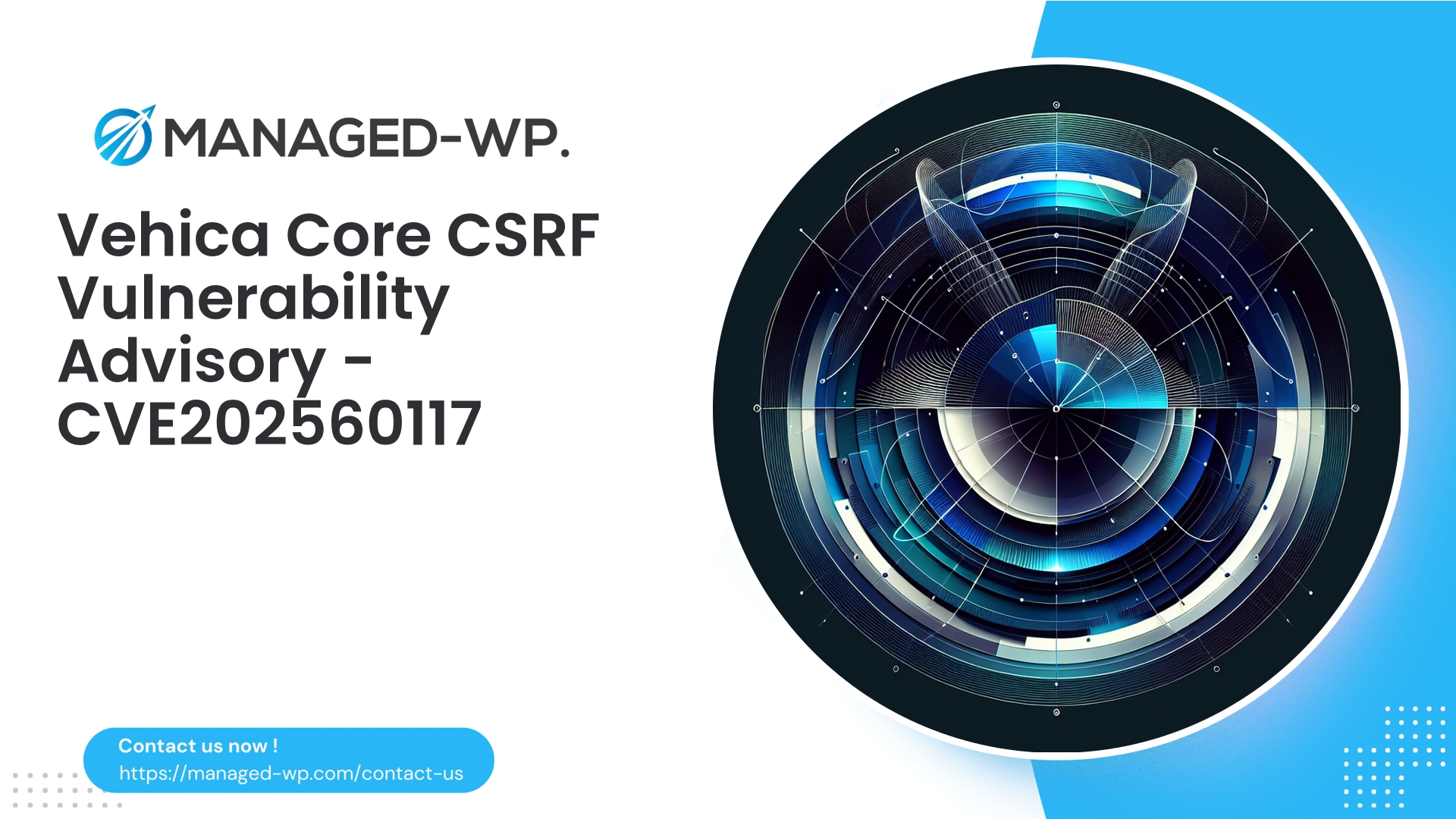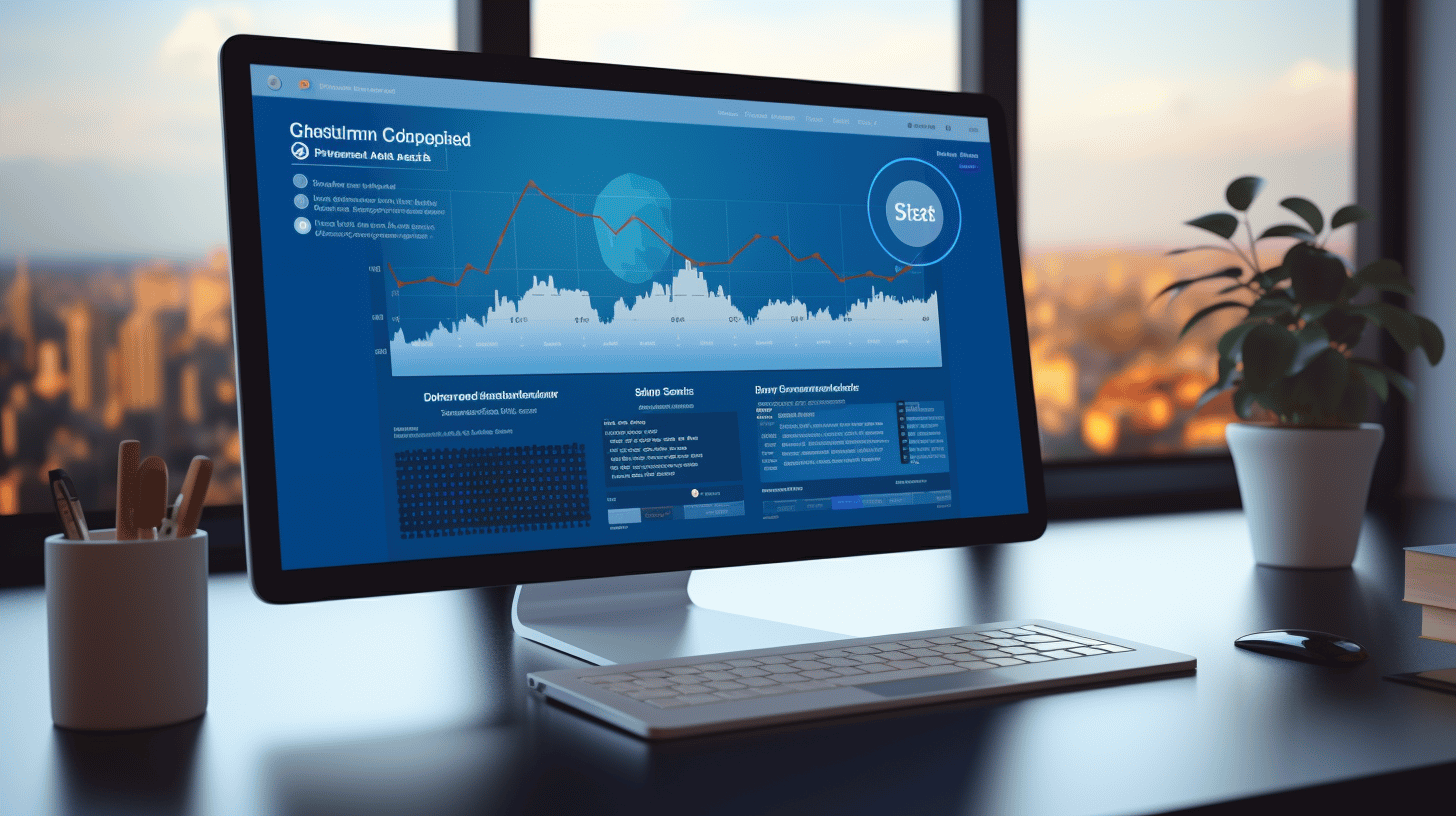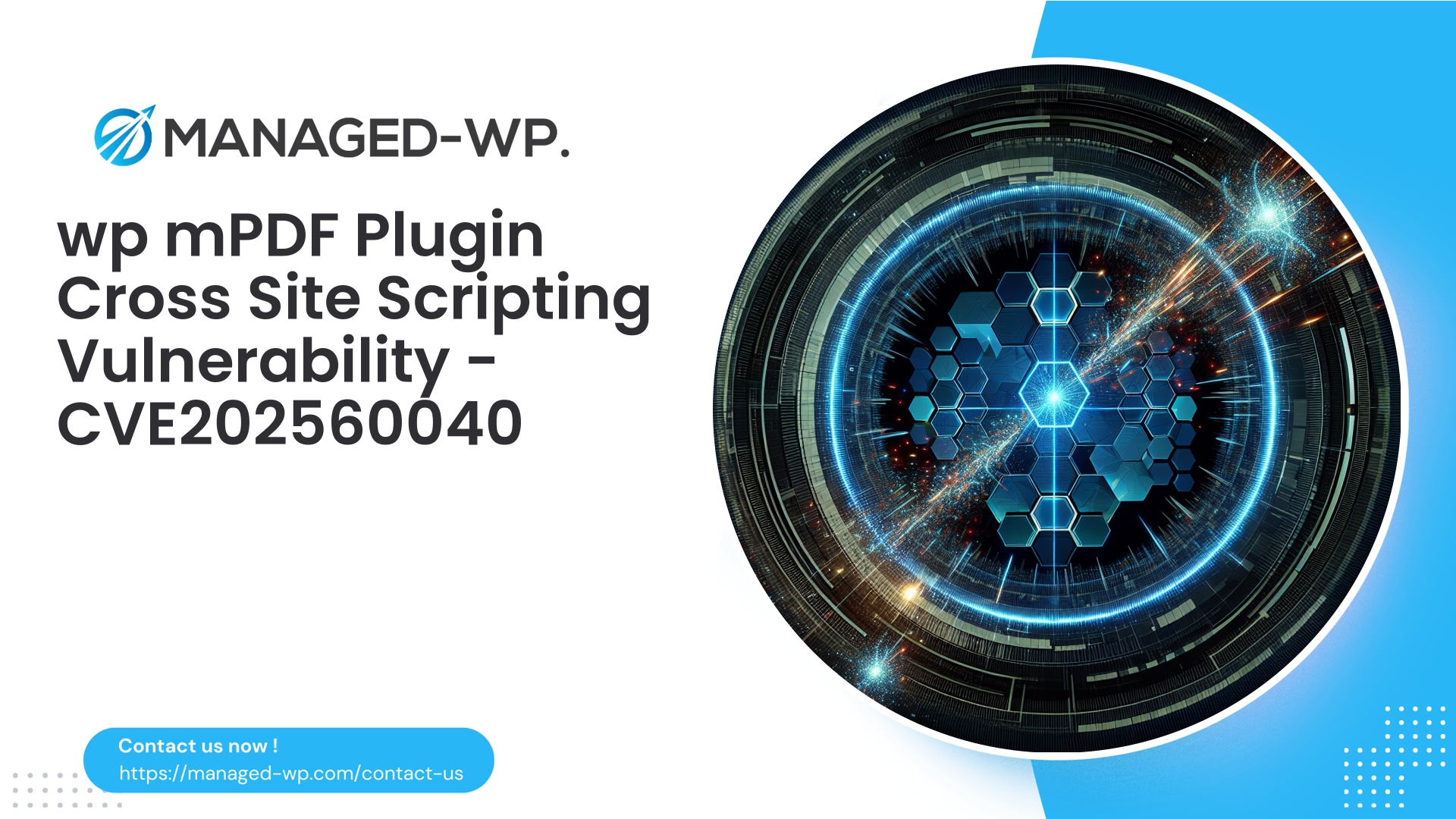| Plugin Name | Vehica Core |
|---|---|
| Type of Vulnerability | CSRF |
| CVE Number | CVE-2025-60117 |
| Urgency | Low |
| CVE Publish Date | 2025-09-26 |
| Source URL | CVE-2025-60117 |
Vehica Core <= 1.0.100 — CSRF Vulnerability (CVE-2025-60117): What Every WordPress Site Owner Must Know & How to Protect Your Site
Cross-Site Request Forgery (CSRF) vulnerabilities can have serious consequences, enabling attackers to coerce authenticated users into unintended actions—potentially escalating privileges or altering critical settings. Recently, the Vehica Core plugin was found vulnerable to a CSRF flaw (CVE-2025-60117) impacting all versions up to and including 1.0.100. In this article, provided by the cybersecurity experts at Managed-WP, we break down the technical aspects, real-world attack scenarios, detection methods, and practical mitigation strategies you need to protect your WordPress environment immediately.
This post is intended for WordPress administrators, developers, and security professionals who want clear, actionable guidance to secure their sites against evolving threats.
Executive Summary
- Vulnerability: Cross-Site Request Forgery (CSRF) in Vehica Core plugin versions ≤ 1.0.100 (CVE-2025-60117).
- Impact: Attackers may trick authenticated users, including administrators, into executing unwanted state-changing actions. Rated low severity (CVSS 4.3), but risk varies according to which plugin actions are exposed.
- Fixed version: 1.0.101. Update without delay.
- Immediate mitigation: Enforce Web Application Firewall (WAF) rules blocking CSRF patterns, limit access to vulnerable endpoints, require nonce and capability checks, and monitor anomalous HTTP requests. Managed-WP’s firewall solutions offer virtual patching to shield your site until updates are applied.
- Disclosure: CVE assigned and patch issued; however, many sites remain vulnerable—multi-layered defense is key.
Understanding CSRF and Its Relevance
CSRF attacks exploit the trust a website places in a user’s browser. When a victim authenticated to a WordPress site visits a malicious webpage, that page can trigger hidden requests (e.g., form submissions or AJAX calls) that perform actions on the user’s behalf without their awareness. Because browsers automatically send cookies and authentication tokens, these requests execute with the victim’s user permissions.
WordPress plugins are especially vulnerable if their endpoints process state-modifying HTTP requests (POST, sometimes GET) without these protections:
- Nonce verification (via
wp_nonce_field,check_admin_referer, orwp_verify_nonce), - Capability checks (e.g.,
current_user_can), - Origin or referrer validation when appropriate.
Lacking these safeguards, an attacker can induce an authenticated admin or user to execute unintended configuration changes, content injection, or enabling features that could lead to greater compromise.
Vehica Core CSRF Vulnerability Overview
- Plugin Affected: Vehica Core
- Versions: ≤ 1.0.100
- Vulnerability Type: Cross-Site Request Forgery (CSRF)
- CVE Identifier: CVE-2025-60117
- Privilege Required: Unauthenticated request initiation; impact depends on victim’s user role.
- Patch Released: 1.0.101
The flaw allows critical plugin endpoints to accept state-changing requests without anti-CSRF protections, enabling attackers to manipulate plugin settings or content if a targeted user is authenticated. Despite the low CVSS score, the real-world threat hinges on the permitted actions for the compromised endpoint and the victim’s role.
Potential Attack Scenarios
Here are a few high-level examples demonstrating how this vulnerability could be exploited:
-
Administrator Targeted
- A malicious webpage silently sends POST requests to Vehica Core’s settings endpoints, altering configurations or injecting malicious API keys.
- An administrator visiting this page inadvertently triggers these actions, potentially opening further attack vectors.
-
Editor or Content Manager Targeted
- If the vulnerable endpoint allows content creation or modification, attackers can insert harmful scripts or SEO spam into listings or posts by triggering requests through the victim’s browser.
- This results in persistent malicious content that can degrade site integrity or search ranking.
-
Users with Lower Privileges
- While limited on their own, low-privilege accounts could be leveraged in chained attacks combined with other flaws (e.g., broken access control or file upload vulnerabilities).
Note on CVSS: The advisory’s “low” rating is influenced by required user interaction and the nature of endpoints involved. Nevertheless, widespread automated attacks and social engineering targeting administrators raise the practical risk—especially on active, multi-admin sites.
How to Check If Your Site Is Affected
- Verify Plugin and Version
- Log into WordPress Admin » Plugins and confirm if Vehica Core is installed and version is ≤ 1.0.100.
- Examine Plugin Endpoints
- Audit admin menu pages, AJAX handlers (
admin-ajax.php), and REST endpoints that may perform configuration changes. - Check if nonce and capability checks are implemented around these endpoints.
- Audit admin menu pages, AJAX handlers (
- Code Review
- Look for
admin_post_*,admin_post_nopriv_*, orwp_ajax_*hooks and verify proper use ofcheck_admin_refererorcheck_ajax_referer. - Confirm REST APIs have appropriate
permission_callbackvalidations.
- Look for
- Audit Logs and Activities
- Monitor for unexpected setting changes, suspicious POST requests to plugin endpoints, and anomalies around plugin actions.
- Enable and review access logs during suspected activity.
Safe Testing Recommendations
If you test for vulnerability on your own WordPress environment, follow these guidelines:
- Use a staging or development environment—never production.
- Create a non-privileged test user and a privileged admin test user.
- Simulate CSRF by attempting state-changing requests from an external domain.
- Confirm whether actions are blocked or allowed.
- Collaborate with skilled developers or security experts when possible.
Warning: Do not attempt to exploit this vulnerability on sites you do not own or have explicit permission to test. Always comply with legal and ethical standards.
How Plugin Developers Should Fix This Vulnerability
Authors of Vehica Core and similar plugins should adhere to these core security principles for all mutable actions:
- Implement WordPress Nonces Properly
- Admin forms must include
wp_nonce_field()and verify withcheck_admin_referer(). - AJAX actions require verification via
check_ajax_referer(). - REST API routes should utilize
permission_callbackfor validating user capability rather than relying solely on nonces.
- Admin forms must include
- Enforce Rigorous Capability Checks
- Use
current_user_can()to ensure users have appropriate permissions before executing actions.
- Use
- Use POST requests for Changing State
- Ensure all state-changing operations are POST requests; keep GET requests safe and idempotent.
- Sanitize and Validate Inputs
- Use WordPress sanitization functions to prevent injection attacks or malformed data.
- Apply Frontend CSRF Defenses
- Embed nonces in frontend forms where authenticated actions are possible, with corresponding backend validation.
- Log Suspicious Activity and Failures
- Record failed nonce checks and improper capability attempts; consider rate-limiting repeated failures.
- Follow Least Privilege Principle
- Restrict capabilities to minimum required to perform actions, minimizing exposure.
- Publish Transparent Security Updates
- Clearly communicate patches and urge all users to update to secure versions promptly.
Site owners must ensure updates are applied as soon as the vendor releases patches.
Urgent Steps for Site Owners If You Cannot Update Immediately
- Update As Soon As Possible
- Apply Vehica Core 1.0.101 or later on a staging environment first, testing compatibility, then deploy to production.
- Temporary Hardening Measures
- Restrict access to vulnerable plugin pages using role and capability controls.
- On server or firewall levels, block POST requests to sensitive plugin endpoints unless accompanied by appropriate tokens.
- Enforce WordPress admin referer header checks that reject unauthorized requests.
- Reduce the number of users with administrator privileges to minimize attack surfaces.
- Force administrator re-authentication to shorten the session window for potential abuse.
- Utilize Virtual Patching via WAF
- Deploy firewall rules that detect and block CSRF exploitation attempts targeting the plugin until you can apply official patches.
- Enhance Admin Awareness
- Educate administrators to be cautious about clicking unfamiliar links while logged in.
- Implement multi-factor authentication (MFA) or use passwordless solutions with re-authentication on sensitive admin actions.
- Perform User Account Reviews
- Audit administrator accounts for legitimacy; remove or demote unnecessary elevated accounts and rotate passwords and secrets.
How Managed-WP Protects Your Site During This Vulnerability Window
At Managed-WP, our layered security approach includes:
- Targeted Virtual Patching: Signature-based rules blocking known exploitation patterns against vulnerable plugin endpoints.
- Heuristic Detection: Flags requests with anomalous behaviors such as auto-submitting forms or suspicious referrers.
- Behavioral Controls: Rate limiting and session-risk evaluations to limit automated attacks.
- Notifications: Immediate alerts to site administrators upon detection of blocked exploit attempts.
- Admin Interface Hardening: Increased scrutiny on wp-admin and admin-ajax.php request flows to mitigate CSRF risks.
While these controls help reduce exposure, they do not replace promptly applying vendor updates.
Detection and Logging Best Practices
Security teams managing logs should watch for the following indicators:
- POST requests to plugin endpoints without valid nonce parameters.
- Requests with suspicious or third-party
RefererorOriginheaders. - Traffic spikes correlating with exploit disclosure dates.
- Unauthorized configuration modifications originating outside wp-admin pages.
- Repeated nonce verification failures from a single client or IP address.
Important fields to log include:
- HTTP method, URI path, and query parameters
- Request headers: Origin, Referer, User-Agent
- POST payload presence and nonce fields
- Authenticated username where available
- IP address and geolocation data
Preserving these logs is essential for effective incident investigation and response.
Developer Guidance: Example Safe Server-side Verification
The following PHP pseudocode offers a conceptual example for securing AJAX handlers:
// Attach AJAX handler
add_action('wp_ajax_vehica_save_settings', 'vehica_save_settings_handler');
function vehica_save_settings_handler() {
// 1) Verify nonce
if (!check_ajax_referer('vehica_save_settings_action', 'vehica_nonce', false)) {
wp_send_json_error(['message' => 'Invalid nonce'], 403);
wp_die();
}
// 2) Capability check
if (!current_user_can('manage_options')) {
wp_send_json_error(['message' => 'Insufficient privileges'], 403);
wp_die();
}
// 3) Sanitize input fields
$option_a = isset($_POST['option_a']) ? sanitize_text_field($_POST['option_a']) : '';
// 4) Perform update and log accordingly
update_option('vehica_option_a', $option_a);
wp_send_json_success(['message' => 'Settings saved']);
}
For REST API endpoints, use permission callbacks:
register_rest_route('vehica/v1', '/save-settings', [
'methods' => 'POST',
'callback' => 'vehica_rest_save_settings',
'permission_callback' => function() {
return current_user_can('manage_options');
},
]);
Post-Exploitation Incident Response Checklist
- Place the site in maintenance mode to prevent new logins during investigation.
- Reset all administrator passwords and invalidate active sessions.
- Rotate API keys, secrets, and sensitive credentials stored via plugin settings or database.
- Conduct comprehensive scans for malware, backdoors, and unauthorized files using trusted tools.
- Review recently modified files, cron jobs, and scheduled tasks for suspicious changes.
- Inspect database content (posts, options, users) for unauthorized modifications or injected content.
- Restore from a verified clean backup if compromise is confirmed.
- Engage professional incident response specialists if needed.
Managed-WP customers have access to virtual patching and expert support to quickly contain threats.
The Importance of Layered Security
Relying on patching alone is insufficient for real-world defense due to:
- Update delays caused by customization or testing requirements
- Social engineering tricking administrators into clicking malicious links
- Attackers chaining multiple vulnerabilities for greater impact
Layered defenses—including patching, WAF virtual patches, least privilege principles, continuous monitoring, and admin security training—work together to reduce risk dramatically. Managed-WP emphasizes this holistic approach to safeguard WordPress environments effectively.
Disclosure Timeline and Final Notes
The vulnerability was responsibly disclosed, assigned CVE-2025-60117, and fixed in Vehica Core 1.0.101. Site administrators should prioritize updating immediately. Should immediate patching be impossible, use virtual patching and hardening techniques outlined in this article.
Recommended Action Plan for the Next 72 Hours
- Confirm whether Vehica Core is installed; verify the version.
-
If version ≤ 1.0.100:
- Schedule an update to version 1.0.101 in a staging environment.
- If tests pass, deploy update to production following backup procedures.
-
If immediate update is not feasible:
- Apply Managed-WP virtual patching rules to block exploitation attempts.
- Reduce number of administrator accounts, enforce reauthentication policies.
- Continuously monitor logs for suspicious plugin endpoint activity and failed nonce verifications.
-
After patching:
- Verify all plugin endpoints perform nonce and capability validation.
- Resume routine monitoring and establish regular plugin security audits.
Ongoing Developer Security Hygiene Checklist
- Regularly audit third-party plugin code for anti-CSRF protections.
- Integrate automated vulnerability and dependency scans with continuous integration workflows.
- Apply least privilege role assignments and separate duties where feasible.
- Enforce multi-factor authentication for all administrative users.
- Schedule periodic security reviews for plugin updates and compatibility assessments.
Introducing Managed-WP Basic: Free Security That Works
Secure Protection That Starts Free — Activate Managed-WP Basic Today
Managed-WP Basic is designed for WordPress site owners seeking effective security with zero hassle. Our free plan offers managed firewall policies, WAF protections, unlimited bandwidth coverage, automated malware scanning, and mitigation for OWASP Top 10 threats. This gives you essential defenses against vulnerabilities like the Vehica Core CSRF while you plan updates.
For enhanced automation, malware removal, advanced reporting, and expert support, consider our Standard and Pro tiers.
Sign up for immediate protection at: https://my.wp-firewall.com/buy/wp-firewall-free-plan/
Final Thoughts from the Managed-WP Security Team
CSRF vulnerabilities are deceptively simple yet potent because they exploit browser trust and authenticated sessions. Even “low severity” advisories can translate into significant operational risk—especially on sites with multiple trusted administrators.
We strongly advise a pragmatic layered approach: apply official patches promptly; reduce exposure windows using virtual patches and WAF protections; enforce secure coding best practices; and maintain vigilant logging and monitoring to detect issues early.
If you require assistance with detection, virtual patching, or remediation planning for a large WordPress estate, Managed-WP Basic delivers immediate firewall protection, with the option to escalate to hands-on expert support.
Stay vigilant, keep your plugins updated, and leverage automated monitoring and virtual patching to mitigate vulnerabilities while maintaining uptime and security.



















